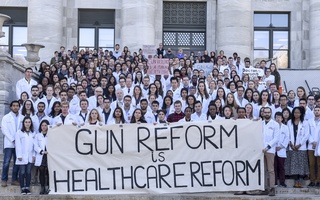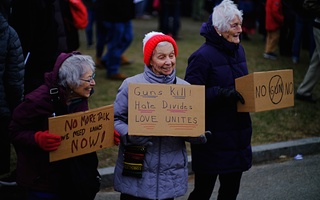This year, gun violence returned to the agenda in city halls around the country. In Boston, shootings increased during the first quarter of 2015, and spiked enough during the summer to spark an official re-launching of the city’s gun buyback program. In Chicago, gun violence continues to outpace last year’s levels, with 400 more shootings as of Tuesday.
The usual culprits are present: the laxity of federal, state and local gun laws and the need for more enforcement of existing laws. In the case of Boston, a recent policy brief from the Harvard Kennedy School’s Rappaport Institute for Greater Boston gives some idea of the scope of the problem. According to the report, of 3,202 handguns recovered by the Boston Police between 2007 and 2013, the federal Bureau of Alcohol, Tobacco, and Firearms was able to trace 1,813. Of those, almost a quarter came from five southern states along I-95 with weaker gun laws than the Commonwealth’s—yet another clear signal of the need for federal action. In addition, about 18 percent of the traced guns came from New Hampshire and Maine, also states with weaker gun laws, and 22.3 percent came from states other than those. Gun violence, the statistics make clear, is a national problem that demands a national solution.
Other elements of the report, however, point to a key area in which Massachusetts could do better. About a third of the traced firearms were purchased in the Commonwealth. Of those almost 84 percent were not recovered from the first purchaser, and of that subset, fully 62.8 percent did not have any records of the secondary transactions that followed their first sale. This failure is one of enforcement. Though Massachusetts has tough secondary sale laws, the Commonwealth has not devised an adequate strategy for implementing them.
While better enforcement will undoubtedly alleviate some issues, however, one lesson of past Massachusetts gun control efforts is that states trying to avoid gun crime may need more comprehensive and aggressive strategies to deal with the problem of secondary sales and to stem the flow of out of state weapons. A Massachusetts law passed in 1998, for example, has had its effectiveness blunted by out-of-state guns.
Massachusetts Democratic primary voters punted on one opportunity for a new approach when they did not nominate former State Senator Warren Tolman as the party’s candidate for Attorney General last year. Tolman, on whose campaign I worked, had a serious plan to use the powers of the Attorney General’s office to mandate the use of smart gun technology in new guns sold in the Commonwealth, the kind of serious step that might finally give law enforcement a leg up against gun violence. Similarly promising proposals have not been forthcoming.
Though better gun regulation may reduce urban violence, however, it cannot address the long-running historical trends of which the current spate of shootings, largely in communities of color, is a symptom.
In Chicago, the flow of guns illustrates part of the connection between unaddressed disparities and the violence that plagues cities. A Chicago Police Department study of guns used in crimes between 2001 and 2012 found, as expected, that neighboring Illinois municipalities and Indiana accounted for a large proportion of recovered guns. The state from which the third-highest number of guns originated, however, was Mississippi, especially the Delta counties of the West. As a New York Times report on the Chicago Police study points out, “during the migration of [African-American] families from the South in the 1940s and 1970s, Chicago was a top destination…”
The prevalence of these historic ties is of more than just academic interest; it also points to the key role that dislocating historical processes have played in creating the conditions for today’s urban violence. An Economist article on the vast racial disparities in the United States put the issue thusly:
“Most of the black Americans who are now struggling are the left-behinds of two great internal migrations. The first, from south to north in the early 20th century, left behind people in the Mississippi Delta, which is now the poorest bit of the country. More recently a second migration has been going on, from northern cities to southern ones…this smaller exodus has left people behind in highly segregated bits of northern cities…”
In short, the poorest parts of the South are one source for the guns used in the violent crimes rocking some of the poorest parts of the North. And public policy has yet to redress the legacies of racial discrimination and violence that produced these current inequities and fuel violence.
Indeed, to “highly segregated” the author might have added the “highly policed.” A last link in the chain connecting contemporary urban gun violence with America’s racial past is the War on Drugs and the phenomenon of mass incarceration that accompanied it, both of which have taken men out of communities and helped stoke violent conditions in inner-city neighborhoods.
As the colder months give cities a slight respite from gun violence, policymakers have much to ponder. Effective gun control will require new strategies around the country. But more fundamentally, America needs integrated economic, legal, and social solutions to the deep-seated racial disparities that are at the root of urban violence around the country.
Nelson L. Barrette '17, a Crimson editorial executive, is a history concentrator in Winthrop House. His column appears on alternate Fridays.
Read more in Opinion
The Elephant Will Take You ThereRecommended Articles
-
 A Predictable Shock
A Predictable Shock -
 After Parkland, HSPH Dean Calls for More Gun Violence Research
After Parkland, HSPH Dean Calls for More Gun Violence Research -
 Longwood Students Protest Gun Violence
Longwood Students Protest Gun Violence -
 Harvard Students Join 'March for Our Lives' Protest in Boston
Harvard Students Join 'March for Our Lives' Protest in Boston -
March for Our Lives is Great, But Not EnoughIf communities took initiative to implement effective preventative measures on a local level, this would have a higher chance of affecting real change.













